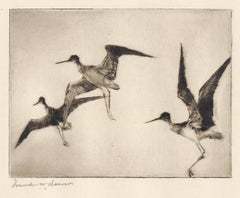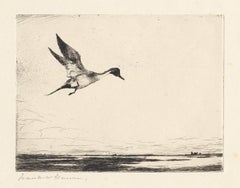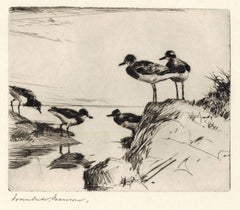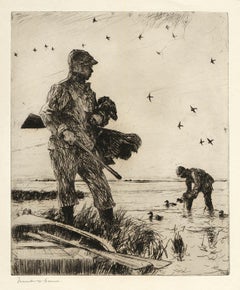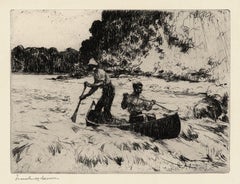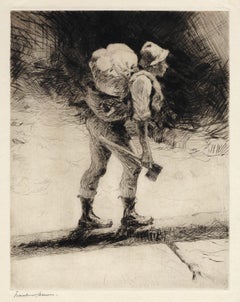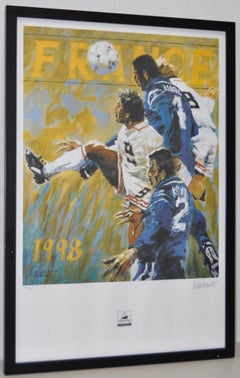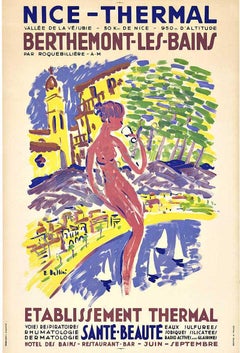Frank Benson More Prints
American, b. 1978
Born in Salem, Massachusetts, American Impressionist Frank Benson studied at the Museum of Fine Arts in Boston under Otto Grundmann and at the Academie Julian with Gustave Boulanger and Jules Lefebvre. Benson was a founding member of the American Academy of Arts and Letters, Guild of Boston Artists and the ‘Ten American Painters,’ a prestigious group of early impressionists. In 1900, Benson purchased a farm and studio on North Haven Island off the coast of Maine. It was there that his style became increasingly impressionistic. Benson is credited with being known as one of the outstanding 20th-century wildlife printmakers.
Benson was a member of the Boston Art Club, National Academy of Design, Society of American Artists and Guild of Boston Artists. He exhibited at the World’s Columbian Exposition in Chicago, Exposition Universelle in Paris, Lousiana Purchase Exposition in St. Louis and the Panama Pacific Exhibition in San Francisco, as well as at the Art Institute of Chicago, Corcoran Gallery, Carnegie Institute, International and Pennsylvania Academy of Fine Arts. Benson’s works are held in numerous public and private collections, including the National Gallery of Art, Smithsonian American Art Museum, Museum of Fine Arts, Worcester Art Museum and Metropolitan Museum of Art.to
6
Overall Width
to
Overall Height
to
3
12
687
450
200
159
6
3
1
4
2
4
4
2
6
Artist: Frank Benson
Three Yellowlegs.
By Frank Benson
Located in New York, NY
The drypoint created in 1920 is a working state, the fourth of eight. The eight states are listed in the Frank W. Benson catalogue raisonne by Adam Paff #184. There are two recorded impressions of this print making it a rare find. It is signed in pencil and inscribed "D-2." The Image size 4 3/8 x 5 13/16" (11.1 x 14.8 cm). The final printed edition of "Three Yellowlegs" was 150.
Frank Weston Benson (1862-1951), well known for his American impressionist paintings, produced an incredible body of prints - etchings, drypoints, and a few lithographs. Born and raised on the North Shore of Massachusetts, Benson, a natural outdoorsman, grew up sailing, fishing, and hunting. While a teenager his fascination with drawing and birding developed simultaneously and continued throughout his life.
His first art instruction was with Otto Grundman at the Museum of Fine Arts in Boston, and then in 1883 in Paris at the Academie Julian where he studied the rigorous ‘ecole des beaux arts’ approach to drawing and painting for two years.
During the early 1880’s Seymour Haden visited Boston giving a series of lectures on etching. This introduction to the European etching...
Category
Early 20th Century American Realist Frank Benson More Prints
Materials
Drypoint
Lone Pintail.
By Frank Benson
Located in New York, NY
This drypoint from 1930 was printed in an edition of 150. It is signed in pencil just under the image in the lower left. Listed in the catalogue raisonne on Frank W. Benson by Adam Paff #303.
Frank Weston Benson (1862-1951), well known for his American impressionist paintings, produced an incredible body of prints - etchings, drypoints, and a few lithographs. Born and raised on the North Shore of Massachusetts, Benson, a natural outdoorsman, grew up sailing, fishing, and hunting. While a teenager his fascination with drawing and birding developed simultaneously and continued throughout his life.
His first art instruction was with Otto Grundman at the Museum of Fine Arts in Boston, and then in 1883 in Paris at the Academie Julian where he studied the rigorous ‘ecole des beaux arts’ approach to drawing and painting for two years.
During the early 1880’s Seymour Haden visited Boston giving a series of lectures on etching. This introduction to the European etching...
Category
1930s American Realist Frank Benson More Prints
Materials
Drypoint
Study of Turnstones.
By Frank Benson
Located in New York, NY
Frank Benson made this drypoint in 1928. The second state of two.
A scarce print with no recorded printings of the second state - presumably, at least two were printed. The image size is 4 7/8 x 5 7/8" (12.4 x 14.9 cm). #282 in the Frank W. Benson catalogue raisonne by Adam Paff.
Frank Weston Benson (1862-1951), well known for his American impressionist paintings, produced an incredible body of prints - etchings, drypoints, and a few lithographs. Born and raised on the North Shore of Massachusetts, Benson, a natural outdoorsman, grew up sailing, fishing, and hunting. While a teenager his fascination with drawing and birding developed simultaneously and continued throughout his life.
His first art instruction was with Otto Grundman at the Museum of Fine Arts in Boston, and then in 1883 in Paris at the Academie Julian where he studied the rigorous ‘ecole des beaux arts’ approach to drawing and painting for two years.
During the early 1880’s Seymour Haden visited Boston giving a series of lectures on etching. This introduction to the European etching...
Category
Early 20th Century American Realist Frank Benson More Prints
Materials
Drypoint
Winter Wildfowling
By Frank Benson
Located in New York, NY
This 1927 etching by Frank W. Benson is entitled Winter Wildfowling. Printed in an edition of 150 this impression is signed in pencil, lower left. The image size 11 7/8 x 9 7/8" (30 x 24.8 cm) and sheet size 15 1/16 x 12 5/8" (38.3 x 32 cm).
FRANK W. BENSON (1862-1951)
Frank Weston Benson, well known for his American impressionist paintings, also produced an incredible body of prints - etchings, drypoints, and a few lithographs. Born and raised on the North Shore of Massachusetts, Benson, a natural outdoorsman, grew up sailing, fishing, and hunting. From a young age, he was fascinated with drawing and birding – this keen interest continued throughout his life.
His first art instruction was with Otto Grundman at the Museum of Fine Arts in Boston, and then in 1883 in Paris at the Academie Julian where he studied the rigorous ‘ecole des beaux arts’ approach to drawing and painting for two years.
During the early 1880’s Seymour Haden visited Boston giving a series of lectures on etching. This introduction to the European etching...
Category
1920s American Impressionist Frank Benson More Prints
Materials
Etching
Running the Rapids
By Frank Benson
Located in New York, NY
The etching "Running the Rapids" was created by Frank Benson in 1927. Printed in an edition of 150, this impression is signed in pencil, lower left. The image size is 5 13/16 x 7 7/8" (14.8 x 20 cm) and sheet size 8 1/16 x 10 5/16" (20.3 x 26.2 cm).
Frank Weston Benson (1862-1951), well known for his American impressionist paintings, also produced an incredible body of prints - etchings, drypoints, and a few lithographs. Born and raised on the North Shore of Massachusetts, Benson, a natural outdoorsman, grew up sailing, fishing, and hunting. From a young age, he was fascinated with drawing and birding – this keen interest continued throughout his life.
His first art instruction was with Otto Grundman at the Museum of Fine Arts in Boston, and then in 1883 in Paris at the Academie Julian where he studied the rigorous ‘ecole des beaux arts’ approach to drawing and painting for two years.
During the early 1880’s Seymour Haden visited Boston giving a series of lectures on etching. This introduction to the European etching...
Category
1920s American Impressionist Frank Benson More Prints
Materials
Etching
The Bridge
By Frank Benson
Located in New York, NY
"The Bridge" is a drypoint by Frank Benson created in 1923. Printed in an edition of 150 this impression is signed in pencil, lower left. The image size is 13 1/2 x 10 5/8" (34.2 x 26.8 cm) and sheet size 16 1/2 x 13 1/16" (41.8 x 33.3 cm).
FRANK W. BENSON (1862-1951)
Frank Weston Benson, well known for his American impressionist paintings, also produced an incredible body of prints - etchings, drypoints, and a few lithographs. Born and raised on the North Shore of Massachusetts, Benson, a natural outdoorsman, grew up sailing, fishing, and hunting. From a young age, he was fascinated with drawing and birding – this keen interest continued throughout his life.
His first art instruction was with Otto Grundman at the Museum of Fine Arts in Boston, and then in 1883 in Paris at the Academie Julian where he studied the rigorous ‘ecole des beaux arts’ approach to drawing and painting for two years.
During the early 1880’s Seymour Haden visited Boston giving a series of lectures on etching. This introduction to the European etching...
Category
1920s American Impressionist Frank Benson More Prints
Materials
Drypoint
Related Items
France World Cup Lithograph by Aldo Luongo c.1998
By Aldo Luongo
Located in San Francisco, CA
FRANCE World Cup Lithograph by Aldo Luongo c.1998
Limited edition France 98' World Cup - Official License
From a very limited edition of 300.
Pencil signed lower right. Edition 24/300 lower left.
This is a rare, very small edition lithograph for the 1998 Soccer World Cup...
Category
Late 20th Century Impressionist Frank Benson More Prints
Materials
Lithograph
Original Nice-Themal spa Berthemont - Les -Bains antique French vintage poster
By Emmanuel Bellini
Located in Spokane, WA
Original French travel poster: Nice - Thermal health spa original vintage poster created by artist Emmanuel Bellini.
Original linen backed, large French travel size: Nice - Therm...
Category
1950s Impressionist Frank Benson More Prints
Materials
Lithograph
$796 Sale Price
20% Off
H 47 in W 32 in D 0.07 in
Starry Night - Limited Edition, Figurative, Contemporary, Star, Night, Child
By Charlie Mackesy
Located in Knowle Lane, Cranleigh
Starry Night is a lithograph based on a watercolour by Charlie Mackesy. The edition is limited to 150 and each piece has been signed by Charlie Mackesy...
Category
2010s Other Art Style Frank Benson More Prints
Materials
Lithograph
$3,340
H 11.82 in W 7.88 in D 0.4 in
Rare 1922 German Jewish Judaica Zion Woodcut Woodblock Print Hermann Fechenbach
By Hermann Israel Fechenbach
Located in Surfside, FL
Title: Zion
Subject: Various biblical images depicting Creation and prayer
1922
Medium: woodcut
Frame: 14" x 18"
Image: 12.5" x 16.75"
Provenance: owned and signed verso by Peter Keil.
Central panel shows the Jewish star over a crown, with inscription in Hebrew: "When God comforts Zion, He will comfort all its ruins and make its deserts look like Eden," and "You have sanctified the seventh day, the goal of creation of Heaven and Earth." This is flanked by a Palestinian farmer pioneer on the left and a Jew praying on the right. The lower tier shows six vignettes of the days of creation from Genesis.
Hermann Fechenbach was born in 1897 in Württemberg, Germany. He grew up in Bad Mergentheim where his parents had an inn, which served as a meeting place for the local Jewish community.
He left school early and through family connections with clothing retailers received training in window dressing. His skill with brush writing was quickly recognised by a big firm in Dortmund where he was responsible for the displays in 10 large windows. He received his conscription papers in 1916 and recalls “being as patriotic as any other fool”. In August 1917 he was involved in a grenade attack in which he was the sole survivor. With serious injuries to both legs he struggled to safety and was eventually transported to a front line “slaughterhouse” where the first of a series of amputations was performed which led to the loss of his left leg.
As a result of his injuries his father dropped his opposition to him becoming an artist. His formal art education started in 1918 with training at a Stuttgart handcraft school for invalids. He attended the Academies in Stuttgart and Munich to learn painting and restoration for 3 years. He was influenced at this time by Max Liebermann. He has been compared to Kathe Kollwitz and was a contemporary of Jakob Steinhardt and hermann Struck. In 1923 he went to Florence for a year. While in Florence he started to produce a series of miniature wood engravings to illustrate the stories of Genesis. This was followed by periods in Pisa, Venice, Vienna and Amsterdam. In 1924 he returned to Stuttgart to paint in the contemporary style “Die Neue Sachlichkeit”. (The New Objectivity was a movement in German art that arose during the 1920s Weimar republic as a reaction against expressionism. The term was coined by Gustav Friedrich Hartlaub, the director of the Kunsthalle in Mannheim, who used it as the title of an art exhibition staged in 1925 to showcase artists who were working in a post-expressionist spirit. These artists—who included Max Beckmann, Otto Dix, George Grosz, Christian Schad, Rudolf Schlichter and Jeanne Mammen) Every spring and autumn he exhibited at the “Kunstgebit” which served as the showcase for all serious artists of the period.
His professional status “Kunstmaler und Grafiker” was recognised by Berlin in 1926. Practically all his work from this period was sold following exhibition.
In 1926 he collaborated with an architect friend to build a bungalow in Hohenheim, a non-Jewish area and a suburb of Stuttgart. Hermann alternately lived in his country bungalow and his town studio, producing portraits for sale or barter and wood engravings for his own pleasure.
In 1930 he married a non-Jewish professional photographer – Greta Batze. They had a studio in Stuttgart, which was used to teach art to a group of 12 students.
In 1933 the Nazi influence removed his name from the official state register together with the right to exhibit. By spending most of his time in his bungalow out of the Jewish quarter the Fechenbachs escaped being registered by the Nazis for some years. They were ostracised and abused by their non-Jewish neighbours. Hermann made weekly visits to friends in town to teach them the practical skills they would need assuming they were to escape from Germany. His energies were directed towards protection and survival.
Ultimately the Nazi persecution forced the Fechenbachs to flee their homeland. They moved to Palestine for 3 months in 1938, but found the political and physical environment unsustainable.
Greta arrived in England penniless in January 1939 to work as a domestic servant and to find a guarantor for her husband. Hermann arrived in May 1939. They moved to Blackheath a few months later. Hermann resumed his painting and engraving as a means of earning a living. He raised enough money to get his parents out of Germany to join his brothers in Argentina but was unable to save his twin sister Rosa who died in a Nazi concentration camp. In 1940 Hermann was interned in Bury as a suspect alien. He protested about his treatment by starting a hunger strike. Because of his persistence he was moved to a prison in Liverpool. From Liverpool he was moved to the Hutchinson Camp in the Isle of Man with fellow artist Kurt Schwitters. Arrangements were made for Greta to be accommodated near by. While interned he commenced work on “Refugee Impressions”, a series of linocut prints (no wood was available).
In 1941 when released from internment the Fechenbachs came under the sponsorship of Dr. Bela Horovitz, the Austrian art publisher who in turn made an introduction to Professor Tancred Borenius.
They were offered lodgings with a family in Oxford. Hermann had his first public exhibition for many years in a small gallery in Oxford in 1942. A second exhibition of oils, pencil drawings, coloured linocut and woodblock prints held later in the year was opened by the mayor of Oxford and critically acclaimed.
In 1944 the first London exhibition took place at the Anglo-Palestinian club in Piccadilly. There were two exhibitions at the Ben Uri Art gallery during this period.
In 1948 a second exhibition at the Anglo Palestinian club was inaugurated by a member of the Rothschild family and several members of Parliament. This was a great success.
In 1944 the Fechenbachs moved to a top floor studio flat in Colet Gardens. Open exhibitions were held each Spring at the Embankment from 1946 to 1951. Movietone News produced a short feature on the artist, which was shown in cinemas in England and Germany.
In 1969 he published the Genesis story in a hard back volume containing 137 prints. He started to research the fate of the entire Jewish community of Bad Mergentheim during the period of the second world war, liaising with historian Dr. Paul Sauer and Professor Max Miller, historian and theologian. In 1972 Kohlhammer published his partly autobiographical book “The last Jews of Mergentheim”. He exhibited at the Anglo-Palestinian Club & the Ben Uri Gallery in the 1940s. His works only came to prominence during the last year of his life when he exhibited at Blond Fine Art.
Peter Keil part of the Junge Wilde. In 1978, the Junge Wilde painting style arose in the German-speaking world in opposition to established avant garde, minimal art and conceptual art. It was linked to the similar Transavanguardia movement in Italy, USA (neo-expressionism) and France (Figuration Libre). They were also known as the Neue Wilde. Artists included; Austria: Siegfried Anzinger, Erwin Bohatsch, Herbert Brandl, Gunter Damisch, Hubert Scheibl, Hubert Schmalix...
Category
1980s Impressionist Frank Benson More Prints
Materials
Woodcut
Mother and Children
By Edna Hibel
Located in San Francisco, CA
This artwork "Mother and Children" c.1970, is a colors lithograph on paper by American artist Edna Hibel, 1917-2014. It is signed and numbered II 3/10 Ed. 200 in pencil by the artist. The The artwork (sheet ) size is 34 x 23 inches, framed size is 40 x 29 inches. Custom framed in original wooden decorated grey/silver frame. It is in excellent condition.
About the artist:
Edna Hibel, a painter of sentimental pictures of children, has had a more than 60-year career as painter and lithographer and promoter of peace through exhibitions of her artwork.
She was born in 1917 in Boston, Massachusetts. Her parents were Abraham and Lena Hibel, and she was raised in the Boston area and educated at Brookline High School where she met her future husband, Theodore Plotkin.
She began to paint when she was nine years old and learned watercolor during summers at the shore where her family vacationed in Maine and Hull, Massachusetts.
Hibel studied at the Boston Museum School of Fine Arts, from 1935-39, receiving a Sturtevant Traveling Fellowship to Mexico. In Boston, in 1966, she began lithography, continuing in 1970 in Zurich, where she still works every year. She has created lithographic works with up to 32 stones (or colors) on paper, silk, wood veneer and porcelain. The latter pieces are called lithographs on porcelain and result from a complicated process, that she keeps a secret, whereby she transfers stone lithographic color separations onto Bavarian hard paste porcelain. Hibel has created the "Arte Ovale" series and various plaques with this technique.
She organized the Edna Hibel Museum of Art, in Jupiter, Florida, to display and promote her work and also created a United Nations stamp, "Mother Earth."
In 1995, she was commissioned by the Foundation of the U.S. National Archives to commemorate the 75th anniversary of women receiving the universal right to vote. At the ceremony, Ms. Lucy Baines Johnson referred to Hibel as the "Heart and Conscience of America."
In November, 2001, the World Cultural Council based in Mexico City gave her the Leonardo da Vinci World Award of Arts.
Hibel's work has been exhibited in museums and galleries in more than 20 countries including Russia, Brazil, China, Costa Rica, and the United States, and under the royal patronage of Count and Countess Bernadotte of Germany, Count Thor Bonde of Sweden, Prince and the late Princess Rainier of Monaco and Her Majesty Queen Elizabeth II of England.
Pope John Paul II gave her a medal of honor as did the late Belgian King Baudouin. She also received honorary Doctoral degrees including from Eureka College, and Northwood University of Florida, Michigan and Texas. She also has received many humanitarian honors for her charitable efforts for children's and medical charities.
Her exhibitions "Golden Bridge" and " Peace Through Wisdom" were efforts to promote peace and cultural understanding between China, the United States, Yugoslavia and Russia, and a television documentary titled "Hibel's Russian Palette" was based on her trips and art shows in Leningrad, now St. Petersburg. In 2001, Edna received a Lifetime Achievement Award from "Women in the Visual Arts," an organization of artists in the South Florida area.
Works in Permanent Collections:
Harvard University
Boston University
Museum of Fine Arts, Boston
Springfield Museum of Arts, Massachusetts
University of New Hampshire
Fleischmann Collection, Cincinnati
Detroit Art Institute
Milwaukee Art Museum
Phoenix Art Museum
La Jolla Museum, California
Lowe Gallery, University of Miami, Florida
Columbus Museum of Arts and Crafts, Georgia
WarrenHall Coutts, Ill, Memorial Museum of Art, El Dorado, Kansas
Palais des Nations,Geneva, Switzerland
United Nations Headquarters, New York City
Norton Gallery, West Palm Beach, Florida
de Saisset Museum, Santa Clara, California
Russian Academy of Art, St. Petersburg, Russia
Hibel Museum of Art, Lake Worth, Florida
One Artist Exhibitions:
Shacknow Museum of Fine Arts, Plantation, Florida, 2000
Cornell Museum of Art and History, Delray Beach, Florida, 1999 (and 1993)
Klutznick National Jewish Museum, Washington, D.C., 1999
The Museum of Printing History, Houston, Texas, 1999 (and 1998)
Mitsukoshi Fine Art Gallery, Tokyo, Japan, 1995 (and 1994)
Lyme Academy of Fine Art, Old Lyme, Connecticut, 1994
Grenchen Art Museum, and Galerie BrechbUhl, Grenchen, Switzerland, 1992
Soviet Union Academy of Art, and Exhibition Hall of the Russian Union of Artists, Leningrad (St. Petersburg),
Russia, U.S.S.R., 1990
Northern Indiana Arts Association Gallery, Munste~ Indiana, 1990
Galerie Vindobona, Bad Kissingen,West Germany, 1988
The National Museum of Women in the Arts, Washington, D.C., 1989
St. Peter An...
Category
Late 20th Century American Impressionist Frank Benson More Prints
Materials
Lithograph
Framed Rubbing of 1550 Brass Monument in Grote Kerk Church, Breda, Netherlands
Located in Alamo, CA
This is an engraving of a tomb monument rubbing that has been highlighted with gold color on a dark grey to black background. The rubbing is of a brass plaque on a stone slab. It has...
Category
16th Century Northern Renaissance Frank Benson More Prints
Materials
Engraving
$1,260 Sale Price
20% Off
H 32.25 in W 32.25 in D 1.5 in
Tete de Veau (Calf's Head)
By Salvador Dalí
Located in OPOLE, PL
Salvador Dali (1904-1989) - Tete de Veau (Calf's Head)
Drypoint etching and watercolor from 1968.
The edition 25/145.
Dimensions of work: 38.5 x 28.5 cm.
Hand signed.
The work i...
Category
1960s Modern Frank Benson More Prints
Materials
Drypoint, Etching
Femmes poules (Hen Women)
By Salvador Dalí
Located in OPOLE, PL
Salvador Dali (1904-1989) - Femmes poules (Hen Women)
Drypoint etching with roulette from 1969.
The edition 62/145.
Dimensions of work: 38 x 28 cm.
Hand signed.
Publisher: Pierr...
Category
1970s Surrealist Frank Benson More Prints
Materials
Drypoint, Etching
Engraving #1 by Ernst Fuchs: KABBALAH (SEFER YETSIRA and 32 PATHS OF WISDOM)
By Ernst Fuchs
Located in Cliffside Park, NJ
Original engraving #7 by Ernst FUCHS from Kabbalah (THIRTY-TWO PATHS OF WISDOM by SEFER YETZIRA), 1978
Etching signed and numbered 16/30 E.A.
Page size - 30 ...
Category
1970s Modern Frank Benson More Prints
Materials
Paper, Etching
Academie de l’Espee Tabula XXI by Girard Thibault 17thc fencing engraving
By Pierre Thibault
Located in Paonia, CO
Hand colored original engraving from the Academie de l’Espee ( full title can be translated as Academy of the Sword: wherein is demonstrated by mathematical rules on the foundation of a mysterious circle the theory and practice of the true and heretofore unknown secrets of handling arms on foot and horseback ) by Girard Thibault...
Category
17th Century Other Art Style Frank Benson More Prints
Materials
Engraving
The Hippies
By Salvador Dalí
Located in OPOLE, PL
Salvador Dali (1904-1989) - The Hippies
Drypoint etching from 1969.
The edition 25/145 on Arches paper.
Dimensions of work: 66 x 51 cm.
Hand signed.
Publisher: Pierre Argillet, ...
Category
1970s Surrealist Frank Benson More Prints
Materials
Drypoint, Etching
Storm at Saint Honoré
By Louise Bourgeois
Located in New York, NY
Richly-inked and superb impression of this engraving and drypoint on cream wove paper. This is the eighth state (of 8). Signed, dated and numbered 28/100 in pencil by Bourgeois. Publ...
Category
1990s Contemporary Frank Benson More Prints
Materials
Engraving, Drypoint, Lithograph
Frank Benson more prints for sale on 1stDibs.
Find a wide variety of authentic Frank Benson more prints available for sale on 1stDibs. You can also browse by medium to find art by Frank Benson in drypoint, engraving, etching and more. Much of the original work by this artist or collective was created during the 20th century and is mostly associated with the Impressionist style. Not every interior allows for large Frank Benson more prints, so small editions measuring 16 inches across are available. Customers who are interested in this artist might also find the work of Frederick Mershimer, Norman Wilkinson CBE PRI, and Lelia Pissarro. Frank Benson more prints prices can differ depending upon medium, time period and other attributes. On 1stDibs, the price for these items starts at $1,200 and tops out at $11,700, while the average work can sell for $4,500.
